UNIT 8:MOTION IN ORBITS
Key unit competence: Evaluate Newton’s law of gravitation and
apply Kepler’s laws of planetary motion.
Unit Objectives:
By the end of this unit I will be able to;
◊ Explain the terms, concept and characteristics of waves properly.
◊ Explain the properties of waves.
◊ Explain the behavior of waves in vibrating strings and applicationsof waves properly.
Introductory Activity
People have always enjoyed viewing stars and planets on clear, dark
nights. It is not only the beauty and variety of objects in the sky that is
so fascinating, but also the search for answers to questions related to
the patterns and motions of those objects.
Until the late 1700s, Jupiter and Saturn were the only outer planets
identified in our solar system because they were visible to the naked
eye. Combined with the inner planets the solar system was believed
to consist of the Sun and six planets, as well as other smaller bodies
such as moons. Some of the earliest investigations in physical science
started with questions that people asked about the night sky.
i) Based on the scenario above and the observation from the
picture. Briefly summarize what is illustrated in the picture.
ii) What is the name of belt separating the largest and smallest planets?
iii) Explain why you think the moon doesn’t fall on the earth.
iv) Why don’t we fly off into space rather than remaining on the
Earth’s surface? Explain your idea.v) Explain why planets move across the sky.
8.1. INTRODUCTION
Gravity is the mysterious force that makes everything fall down towards
the Earth. But after research it has turned out that all objects have gravity.
It’s just that some objects, like the Earth and the Sun, have a stronger
gravity than others. How much gravity an object has depends its mass.
It also depends on how close you are to the object. The closer you are, thestronger the gravity.
Gravity is very important to our everyday lives. Without Earth’s gravity
we would fly right off it. If you kicked a ball, it would fly off forever. While
it might be fun to try for a few minutes, we certainly can’t live without
gravity. Gravity also is important on a larger scale. It is the Sun’s gravity
that keeps the Earth in orbit around the Sun. Life on Earth needs the Sun’s
light and warmth to survive. Gravity helps the Earth to stay at just theright distance from the Sun, so it’s not too hot or too cold.
8.2. NEWTON’S LAW OF GRAVITATION
This is also called the universal law of gravitation or inverse square
law. It states that “the gravitational force of attraction between two
masses m1 and m2 is directly proportional to the product of masses
and inversely proportional to the square of their mean distance
apart.” Remember two objects exert equal and opposite force of gravitation
on each other.
Notes:
• The value of G in the laboratory was first determined by Cavendishusing the torsional balance.
Properties of Gravitational Force
• It is always attractive in nature while electric and magnetic force can
be attractive or repulsive.
• It is independent of the medium between the particles while electric
and magnetic forces depend on the nature of the medium between the particles.
• It holds good over a wide range of distances. It is found true for
interplanetary to interatomic distances.
• It is a central force, i.e. it acts along the line joining the centres of two
interacting bodies.
• It is a two-body interaction, i.e. gravitational force between two particles
is independent of the presence or absence of other particles; so, the
principle of superposition is valid, i.e. force on a particle due to numberof particles is the resultant of forces due to individual particles, i.e.
• It is a conservative force, i.e. work done by it is path independent or
work done in moving a particle round a closed path under the action
of gravitational force is zero.
• It is an action reaction pair, i.e. the force with which one body (say,
earth) attracts the second body (say, moon) is equal to the force with
which moon attracts the earth. This is in accordance with Newton’s
third law of motion.
8.3. KEPLER’S LAWS OF PLANETARY MOTION
Planets are large natural bodies rotating around a star in definite orbits.
The planetary system of the star sun, called solar system, consists of eight
planets, viz. Mercury, Venus, Earth, Mars, Jupiter, Saturn, Uranus, and
Neptune . Out of these planets mercury is the smallest, closest to the sun.
jupiter is the largest and has the maximum number of moons. Venus is
closest to the earth and the brightest planet. Kepler, after a life time study,
worked out three empirical laws which govern the motion of these planetsand are known as Kepler’s laws of planetary motion. These are stated below.
1st Law: This law is called the law of orbits and it states that planets move
in ellipses with the sun as one of their foci. It can also be stated that planetsdescribe ellipses about the sun as one focus. (Fig. 8.2)
2nd Law: This is called the law of areas and states that the line joining the
sun and the planet sweeps out equal areas in equal periods of time. (Fig. 8.3)

3rd Law: The law of periods states that the square of the period T of
revolution of any planet is proportional to the cube of its mean distance Rfrom the sun. (Fig. 8.4)
8.4. VERIFICATION OF KEPLER’S THIRD LAW OF
PLANETARY MOTION
Assuming that a planet’s orbit is circular (which is not exactly correct but is
a good approximation in most cases), then the mean distance from the sun
is constant –radius. Suppose, a planet of mass m2 moving around the sun of mass m1
If the motion of the planet is circular, there are two types of forces:
(a) Gravitational force of attraction F1 between the sun and the planet,

EXAMPLE 8.1:
The distance of a planet from the sun is 5 times the distance between the
earth and the sun. What is the time period of revolution of the planet?
Solution:According to Kepler’s law

Background information:
Kepler’s third law (the Harmonic Law), relates the orbital period of a
planet (that is, the time it takes a planet to complete one orbit) to
its mean distance from the Sun. This law states that the closest
planets travel at the greatest speeds and have the shortest orbital periods.




Source of data: lunar and planetary science by National Aeronautics and
Space Administration (NASA)
Use the data provided in the tables above and find the orbital period for
each orbital radius for each planet. Enter the data into spreadsheets
and plot line graphs for the data, with each planet’s orbital radius on theX-axis and its orbital period on the Y-axis.
Describe any general trends you see:
a) Is there a systematic relationship between period and radius for the
planets for each case?
b) How would you describe this relationship in words?
c) Is the relationship you observe consistent with Kepler’s third law?d) How could you improve your test for consistency?
Application Activity 8.1
Using the cross and down clues write the correct words in the numberedgrid below.
Across
6. The second largest planet with many rings.
7. This planet’s blue color is the result of absorption of red light by
methane in the upper atmosphere.
8. A small body that circles the Sun with a highly elliptical orbit.
9. An object in orbit around a planet.
10. A large cloud of dust and gas which escapes from the nucleus of an
active comet.
DOWN
1. It is the brightest object in the sky except for the Sun and the Moon.
2. The largest object in the solar system.
3. The only planet whose English name does not derive from Greek/
Roman mythology.
4. An area seen as a dark spot on the photosphere of the Sun.
5. This planet is more than twice as massive as all the other planets combined.
8.5. ACCELERATION DUE TO GRAVITY AT THE
SURFACE OF THE EARTH
The force of attraction exerted by the earth on a body is called gravitational
pull or gravity. We know that when force acts on a body, it produces acceleration.
Therefore, a body under the effect of gravitational pull must accelerate.
The acceleration produced in the motion of a body under the effect of gravity
is called acceleration due to gravity (g). Consider a body of mass m lying on the surface
of earth. Then gravitational force on the body is given by:

• Acceleration due to gravity is a vector quantity and its direction is
always towards the centre of the planet.
• Dimensions of [g] = [LT –2]
• Average value of g is taken as 9.8 m/s2 or 981 cm/s2, on the surface of
the earth at mean sea level.
• In general, the value of acceleration due to gravity vary due to the
following factors: (a) Shape of the earth, (b) Height above the earth
surface, (c) Depth below the earth surface and (d) Axial rotation of the earth.
EXAMPLE 8.4:
The moon’s radius is (1/4)th of that of earth and its mass is 1/80 times that
of the earth. If g represents the acceleration due to gravity on the surfaceof the earth, what is acceleration due to gravity on the surface of the moon?
8.6. VARIATION OF ACCELERATION DUE TO
GRAVITY WITH HEIGHT
Consider a particle placed at a height h above the surface of the earth whereacceleration due to gravity is g′ as shown on the figure below.



EXAMPLE 8.5:
The acceleration of a body due to the attraction of the earth (radius R) is
g. Find the acceleration due to gravity at a distance 2R from the surface of the earth.
EXAMPLE 8.6:
Find the height of the point above the earth’s surface, at which acceleration
due to gravity becomes 1% of its value at the surface is (Radius of the earth = R).
Notes:
• The value of g decreases on going below the surface of the earth. From
equation 8-12, we get g′ ∝ (R – d). So it is clear that if d increases, thevalue of g decreases.
Combining the graphs for variation of acceleration due to gravity below and
above the surface of the earth will give the graph as shown below:
EXAMPLE 8.7:
Weight of a body of mass m decreases by 1% when it is raised to height h
above the earth’s surface. If the body is taken to a depth h in a mine, whatis the change in its weight?
8.8. VARIATION IN G DUE TO ROTATION OF EARTH
As the earth rotates, a body placed on its surface moves along the circular
path and hence experiences centrifugal force. Due to it, the apparent weight
of the body decreases.
Since the magnitude of centrifugal force varies with the latitude of the
place, therefore the apparent weight of the body varies with latitude due tovariation in the magnitude of centrifugal force on the body.





EXAMPLE 8.9:
What is the angular velocity of the earth with which it has to rotate so that
acceleration due to gravity on 60° latitude becomes zero? (Radius of earth= 6400 km. At the poles g = 10 ms–2)
8.9. VARIATION OF ‘G’ DUE TO SHAPE OF EARTH
Earth is elliptical in shape. It is flattened at the poles and bulged out at the equator.
8.10. ROCKETS
A rocket is a device that produces thrust by ejecting
stored matter. A rocket moves forward when gas expelled from
the rear of a rocket pushes it in the opposite direction. From
Newton’s laws of motion, for every action, there is an equal
and opposite reaction. In a rocket, fuel is burned to make a
hot gas and this hot gas is forced out of narrow nozzles in the
back of the rocket, propelling the rocket forward.
Spacecraft Propulsion
Spacecraft Propulsion is characterized in general by its complete integration
within the spacecraft (e.g. satellites). Its function is to provide forces and
torques in (empty) space to:
• transfer the spacecraft: used for interplanetary travel
• position the spacecraft: used for orbit control• orient the spacecraft: used for altitude control
The jet propulsion systems for launching rockets are also called primary
propulsion systems. Spacecrafts, e.g. satellites, are operated by secondary
propulsion systems.
Characteristics of Spacecraft Propulsion Systems
In order to fulfill altitude and orbit operational requirements of spacecraft,
spacecraft propulsion systems are characterized by:
• Very high velocity increment capability (many km/s)
• Low thrust levels (1 mN to 500 N) with low acceleration levels
• Continuous operation mode for orbit control
• Pulsed operation mode for altitude control
• Predictable, accurate and repeatable performance (impulse bits)
• Reliable, leak-free long time operation (storable propellants)
• Minimum and predictable thrust exhaust impingement effects
Classification of Propulsion Systems
Spacecraft propulsion can be classified according to the source of energy
utilized for the ejection of propellant:
• Chemical propulsion use heat energy produced by a chemical
reaction to generate gases at high temperature and pressure in a
combustion chamber. These hot gases are accelerated through a
nozzle and ejected from the system at a high exit velocity to produce
thrust force.
• Electric propulsion uses electric or electromagnetic energy to eject
matter at high velocity to produce thrust force.
• Nuclear propulsion uses energy from a nuclear reactor to heat
gases which are then accelerated through a nozzle and ejected fromthe system at a high exit velocity to produce thrust force.
Notes:
• While chemical and electric systems are used for the propulsion of
today’s spacecrafts, nuclear propulsion is still under study. Therefore,
only chemical and electric propulsion will be dealt with in this book.
8.11. SATELLITES
A satellite is an artificial or a natural body placed in orbit round the earth
or another planet in order to collect information or for communication.
Communication satellites are satellites that are used specifically to
communicate. Part of that communication will be the usual commands and
signals we get from any satellite. The payload of the satellite consists of
huge collection of powerful radio transmitters and a big dish or something
like that, to enable it to talk to things on the ground. And we’ll use them
to transmit TV signals, to transmit radio signals, and in some cases, it
might be to be transmit internet signals. So, all of that gets turned into
radio somehow and transmitted up into space and then bounced back downsomewhere else.
There is only one main force acting on a satellite when it is in orbit, and
that is the gravitational force exerted on the satellite by the Earth. This
force is constantly pulling the satellite towards the centre of the Earth.
A satellite doesn’t fall straight down to the Earth because of its velocity.
Throughout a satellite’s orbit there is a perfect balance between the
gravitational force due to the Earth, and the centripetal force necessary tomaintain the orbit of the satellite.
8.11.1. Orbital Velocity of Satellite.
Satellites are natural or artificial bodies describing orbit around a planet under
its gravitational attraction. Moon is a natural satellite while INSAT
1B is an artificial satellite of the earth. Condition for establishment of artificial satellite
is that the centre of orbit of satellite must coincide with centreof earth or satellite must move around great circle of earth.
Orbital velocity of a satellite is the velocity required to put the satellite into
its orbit around the earth. For revolution of satellite around the earth, thegravitational pull provides the required centripetal force.

Notes:
• Orbital velocity is independent of the mass of the orbiting body and is
always along the tangent of the orbit, i.e. satellites of deferent masses
have the same orbital velocity, if they are in the same orbit.
• Orbital velocity depends on the mass of central body and radius of orbit.
• For a given planet, greater the radius of orbit, lesser will be the orbitalvelocity of the satellite
• Orbital velocity of the satellite when it revolves very close to the
surface of the planet:
EXAMPLE 8.10:
Two satellites A and B go round a planet P in circular orbits having radii
4R and R respectively. If the speed of the satellite A is 3v, what is the speedof the satellite B?
Orbital velocity increases by 0.5%.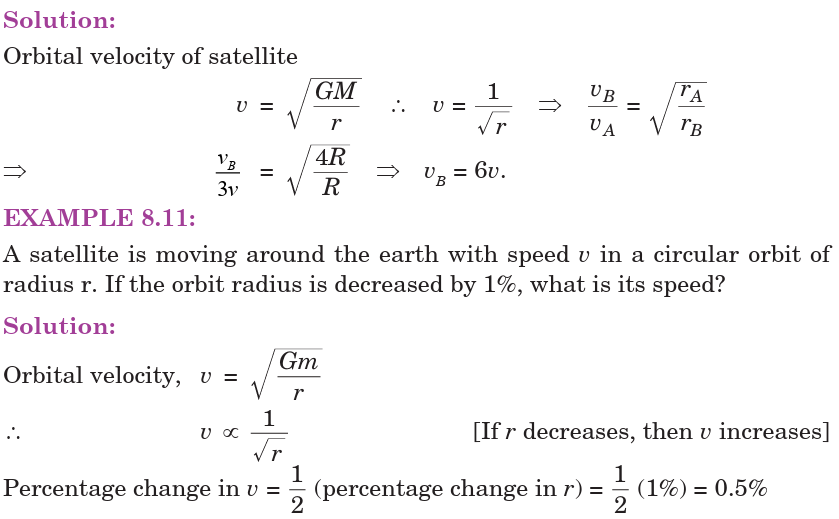
8.11.2. Time Period of SatelliteIt is the time taken by satellite to go once around the earth.

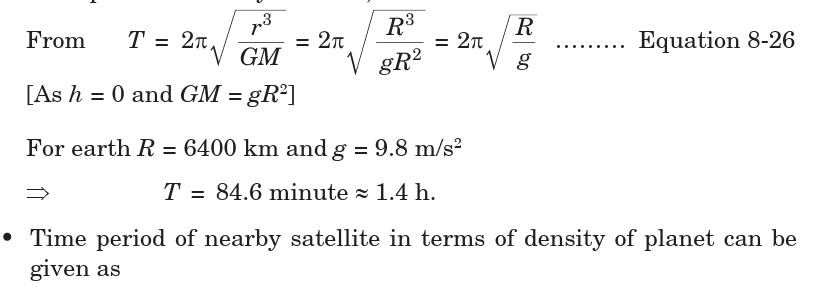
EXAMPLE 8.12: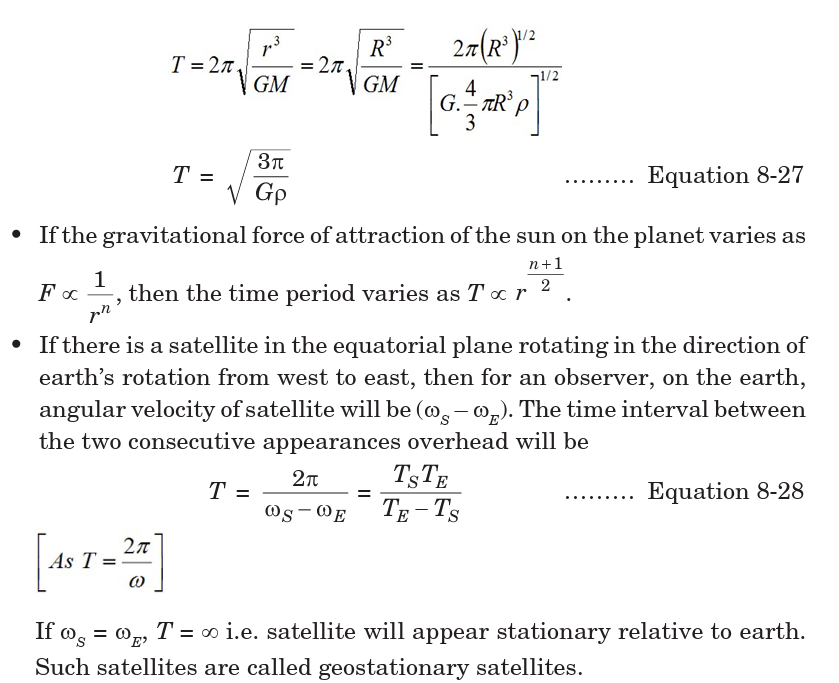
A satellite is launched into a circular orbit of radius ‘R’ around earth while
a second satellite is launched into an orbit of radius 1.02 R. What is the
percentage difference in the time periods of the two satellites?
Solution:Orbital radius of second satellite is 2% more than the first satellite.


EXAMPLE 8.13:
What is the periodic time of a satellite revolving above Earth’s surface at aheight equal to R, where R is the radius of Earth?
By knowing the value of time period we can calculate the height of satellite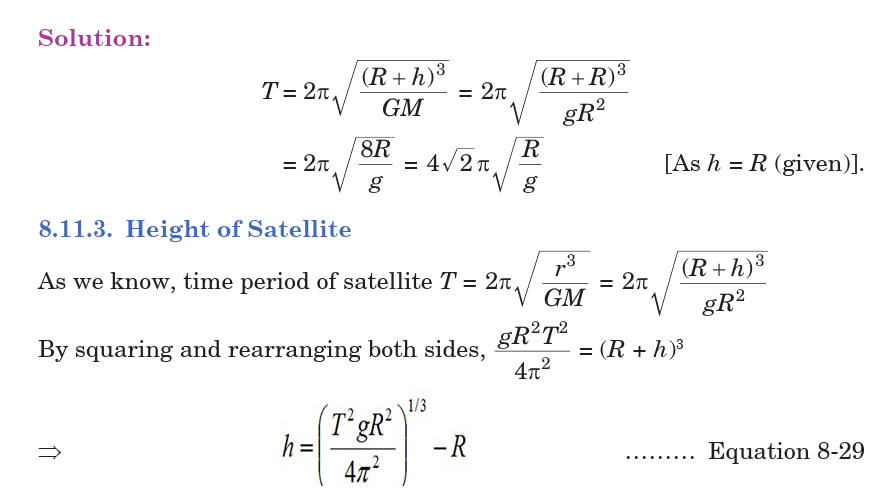
the surface of the earth.
EXAMPLE 8.14:
Given radius of earth ‘R’ and length of a day ‘T’, what is the height of ageostationary satellite

EXAMPLE 8.15:
A satellite is revolving round the earth in circular orbit at some height above
surface of the earth. It takes 5.26 × 103 seconds to complete a revolution
while its centripetal acceleration is 9.32 m/s2. What is the height of satelliteabove the surface of earth? (Radius of the earth 6.37 × 106 m)
8.11.4. Geostationary Satellite
The satellite which appears stationary relative to earth is called
geostationary or geosynchronous satellite, e.g. communication satellite.
A geostationary satellite always stays over the same place above the earth.
Such a satellite is never at rest. It appears stationary due to its zero relative
velocity with respect to that place on earth.
The orbit of a geostationary satellite is known as the parking orbit.
Notes:
• It should revolve in an orbit concentric and coplanar with the equatorial plane.
• Its sense of rotation should be same as that of earth about its own
axis, i.e. in anti-clockwise direction (from west to east).
• Its period of revolution around the earth should be the same as that of
earth about its own axis.T = 24 h = 86400 s
8.11.5. Energy of Satellite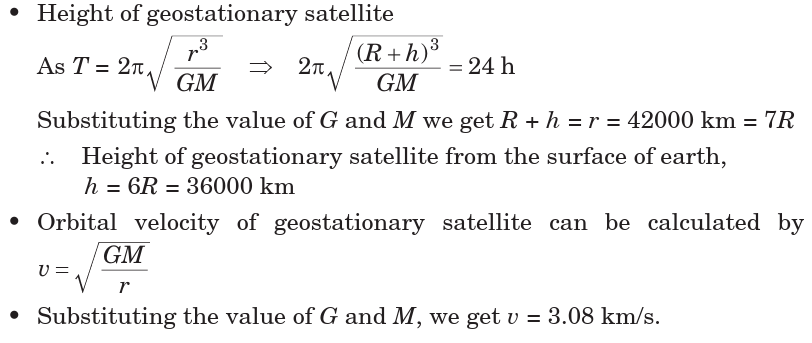
When a satellite revolves around a planet in its orbit, it possesses both
potential energy (due to its position against gravitational pull of earth) andkinetic energy (due to orbital motion).
Notes
• Kinetic energy, potential energy or total energy of a satellite depends
on the mass of the satellite and the central body and also on the radius
of the orbit.
• From the above expressions we can say that
Kinetic energy (K) = – (Total energy)
Potential energy (U) = 2 (Total energy)Potential energy (K) = – 2 (Kinetic energy)
• If the orbit of a satellite is elliptical, then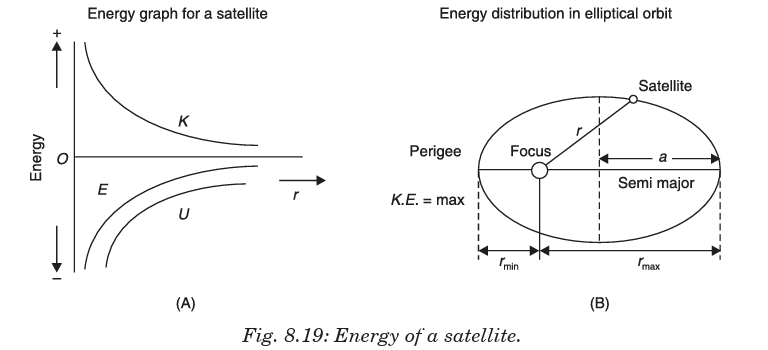

2- = constant; where a is semi-major axis.
(b) Kinetic energy (K) will be maximum when the satellite is closest
to the central body (at perigee) and maximum when it is farthest
from the central body (at apogee).
(c) Potential energy (U) will be minimum when kinetic energy is
maximum, i.e. when satellite is closest to the central body (at
perigee). Potential energy is maximum when kinetic energy is
minimum, i.e. the satellite is farthest from the central body (at apogee).
• Binding Energy: Total energy of a satellite in its orbit is negative.
Negative energy means that the satellite is bound to the central body
by an attractive force and energy must be supplied to remove it from
the orbit to infinity. The energy required to remove the satellite fromits orbit to infinity is called Binding Energy of the system, i.e.
Application Activity 8.2
1. The distance of Neptune and Saturn from sun are nearly 1013 and
1012 metres respectively. Assuming that they move in circular orbits,
what will be their periodic times in the ratio?
2. A spherical planet far out in space has a mass M0
and diameter D0
A particle of mass m falling freely near the surface of this planet
will experience an acceleration due to gravity which is equal to g.
Derive the expression of g in terms of D.
3. At surface of earth, weight of a person is 72 N. What is his weight at
height R/2 from surface of earth (R = radius of earth)?
4. Assuming earth to be a sphere of a uniform density, what is the
value of gravitational acceleration in a mine 100 km below the
earth’s surface (Given R = 6400 km)?
5. If the gravitational force between two objects was proportional to
1/R; where R is separation between them, then a particle in circular
orbit under such a force would have its orbital speed v proportional
to which value?
6. An earth satellite S has an orbital radius which is 4 times that of acommunication satellite C. What is its period of revolution?
8.12 TYPES AND APPLICATIONS OF SATELLITE SYSTEMS
Four different types of satellite orbits have been identified depending on
the shape and diameter of each orbit:
• GEO (Geo-stationary earth orbit)
• MEO (medium earth orbit)
• LEO (Low earth orbit) and• HEO (Highly elliptical orbit)
GEO (geostationary orbit)
A geostationary orbit or geosynchronous equatorial orbit (GEO) has a
circular orbit 35,786 kilometres above the Earth’s equator and following the
direction of the Earth’s rotation. An object in such an orbit has an orbital
period equal to the Earth’s rotational period (one sidereal day) and thusappears motionless, at a fixed position in the sky, to ground observers.
Most common geostationary satellites are either weather satellites or
communication satellites relaying signals between two or more ground
stations and satellites that broadcast signals to a large area on the planet.
All radio and TV, whether satellite etc. are launched in this orbit.
Advantages of Geo-Stationary Earth Orbit
1. It is possible to cover almost all parts of the earth with just 3 geo satellites.
2. Antennas need not be adjusted every now and then, but can be fixed
permanently.
3. The life-time of a GEO satellite is quite high usually around 15 years.
Disadvantages of Geo-Stationary Earth Orbit
1. Larger antennas are required for northern/southern regions of the earth.
2. High buildings in a city limit the transmission quality.
3. High transmission power is required.
4. These satellites cannot be used for small mobile phones.
5. Fixing a satellite at Geo stationary orbit is very expensive.
LEO (Low Earth Orbit)
Satellites in low Earth orbits are normally military reconnaissance satellites
that can locate out tanks from 160 km above the Earth. They orbit the earth
very quickly, one complete orbit normally taking 90 minutes. However,
these orbits have very short lifetimes in the order of weeks compared withdecades for geostationary satellites. Simple launch vehicles can be used to
Low Earth Orbit is used for things that we want to visit often with the
Space Shuttle, like the Hubble Space Telescope and the International Space
Station. This is convenient for installing new instruments, fixing things
that are broken, and inspecting damage. It is also about the only way we
can have people go up, do experiments, and return in a relatively short time.
A special type of LEO is the Polar Orbit. This is a
LEO with a high inclination angle (close to
90 degrees). This means the satellite travels over the poles.
Advantages of Low Earth Orbit
1. The antennas can have low transmission power of about 1 watt.
2. The delay of packets is relatively low.
3. Useful for smaller foot prints
Disadvantages of Low Earth Orbit
1. If global coverage is required, it requires at least 50-200 satellites in this orbit.
2. Special handover mechanisms are required.
3. These satellites involve complex design.
4. Very short life: Time of 5-8 years. Assuming 48 satellites with a life-time
of 8 years each, a new satellite is needed every 2 months.
5. Data packets should be routed from satellite to satellite.
MEO (Medium Earth Orbit) or ICO (Intermediate Circular Orbit)
Medium Earth Orbit satellites move around the earth at a height of 6000
20000 km above earth’s surface. Their signal takes 50 to 150 milliseconds
to make the round trip. MEO satellites cover more earth area than LEOs
but have a higher latency. MEOS are often used in conjunction with GEOsatellite systems.
Advantages of Medium Earth Orbit
1. Compared to LEO system, MEO requires only a dozen satellites.
2. Simple in design.3. Requires very few handovers.
Disadvantages of Medium Earth Orbit
1. Satellites require higher transmission power.
2. Special antennas are required.
HEO (Highly Elliptical Orbit)
A satellite in elliptical orbit follows an oval-shaped path. One part of the orbit
is closest to the centre of Earth (perigee) and another part is farthest away
(apogee). A satellite in this type of orbit generally has an inclination angle of
64 degrees and takes about 12 hours to circle the planet. This type of orbitcovers regions of high latitude for a large fraction of its orbital period
8.13. COSMIC VELOCITY FIRST, SECOND AND THIRD
The cosmic velocity is the initial velocity which a body must have to be able
to overcome the gravity of another object.We have:
1. The first cosmic velocity
2. Second cosmic velocity3. The third cosmic velocity
8.13.1. The first cosmic velocity
As you know the satellites which were sent by a human are orbiting around
the Earth. They had to be launched with a very high velocity, namely, withthe first cosmic velocity.
This velocity can be calculated using the gravitational force and the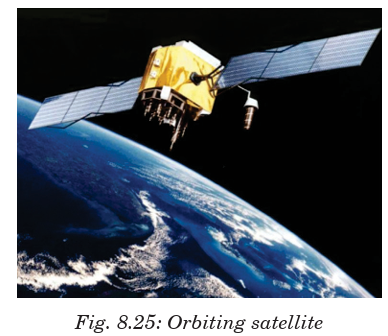
centripetal force of the satellite:
Satellites must have extremely high velocity to orbit around the Earth. In
fact, satellites go around the Earth at the height h = 160 km in order not tobreak into the atmosphere.
8.13.2. Second cosmic velocity (escape velocity)
In the previous section we calculated the velocity which a body has to have
to go around the Earth, which means that we calculated the value of the first
cosmic velocity. Now it is time to give attention to calculating the second cosmic
velocity -it is the speed needed to “break free” from the gravitational
attraction of the Earth or celestial body to which it is attract.
In order to understand this issue we should know something about kineticand potential energy.
This value is calculated using the fact that as the body moves away from
the Earth, the kinetic energy decreases and the potential energy increases.
At infinity, both the energies are equal to zero, because, when the distance
between the body and the Earth increases, the kinetic energy decreases andat infinity, it has the value of 0.
The potential energy at infinity has got the highest value but if we put
infinity in the previous formula, we will obtain zero (or an extremely small
fraction).The value of the second cosmic velocity is calculated as follows;
We can also obtain the value of the second cosmic velocity by multiply the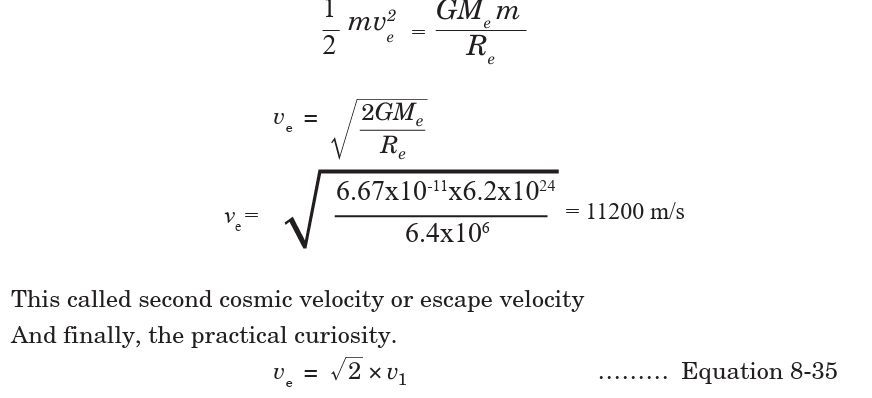
value of the first cosmic velocity by the square root of two.
8.13.3. The 3rd cosmic velocity
The third cosmic velocity is the initial velocity which a body has to have to
leave the Solar System and its value is:
v3= 16.7 km/s at solar system
At the surface of the Earth, this velocity is about 42 km/s. But due to its
revolution, it is enough to launch the body with velocity 16.7 km/s in the
direction of this movement.
8.13.4. The fourth cosmic velocityIt is the initial velocity which a body should have to leave the Milky Way.
This velocity is about 350 km/s but since Sun is going around the galaxy
centre, so it is enough to launch the body with the velocity of 130 km/s inthe direction of the Sun’s movement.
Application Activity 8.3
The grid shown below contains terms used in this unit. Highlight at
least 25 terms. Construct 10 sentences in context of motion in orbitsusing those words found in the grid.

Application Activity 8.4
Using the Across and Down clues, write the correct words in thenumbered grid below.
ACROSS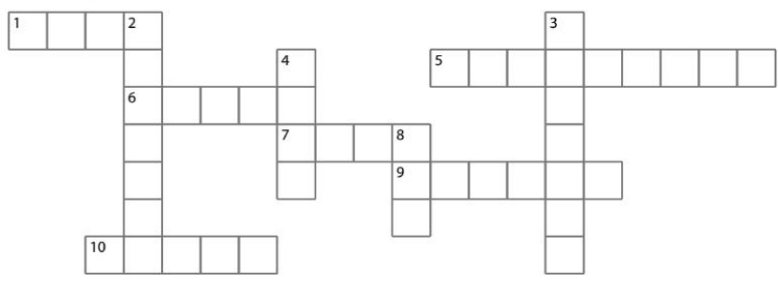
1. The only natural satellite of Earth.
5. An object in orbit around a planet.
6. The smallest planet and farthest from the Sun.
7. This planet probably got this name due to its red color and is
sometimes referred to as the Red Planet.
9. This planet’s blue color is the result of absorption of red light by
methane in the upper atmosphere.
10. It is the brightest object in the sky except for the Sun and the moon.
DOWN
2. Named after the Roman god of the sea.
3. The closest planet to the Sun and the eighth largest.
4. A large cloud of dust and gas which escapes from the nucleus of an
active comet.8. The largest object in the solar system.
END OF UNIT ASSESSMENT
1. A satellite A of mass m is at a distance of r from the centre of the earth.
Another satellite B of mass 2m is at distance of 2r from the earth’s
centre. What is the ratio of their time periods?
2. Mass of moon is 7.34 × 1022 kg. If the acceleration due to gravity
on the moon is 1.4 m/s2, find the radius of moon. Use (G = 6.67 ×
10–11 Nm2/kg2).
3. A planet has mass 1/10 of that of earth, while radius is 1/3 that of
earth. If a person can throw a stone on earth surface to a height of 90 m,to what height will he be able to throw the stone on that planet?
4. If the distance between centres of earth and moon is D and the mass of
earth is 81 times the mass of moon, then at what distance from centre ofearth the gravitational force will be zero?
5. What is the depth d at which the value of acceleration due to gravity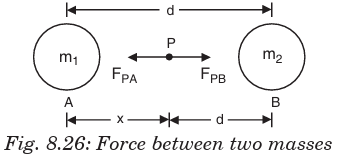
becomes n/1
times the value at the surface? [R = radius of the earth]
6. The distance between centre of the earth and moon is 384000 km. If the
mass of the earth is 6 × 1024 kg and G = 6.67 × 10–11 Nm2/kg2, what is the
speed of the moon?
7. One project after deviation from its path, starts moving round the earth
in a circular path at radius equal to nine times the radius at earth R,
what is its time?
8. A satellite A of mass m is revolving round the earth at a height ‘r’ from
the centre. Another satellite B of mass 2m is revolving at a height 2r.What is the ratio of their time periods?
UNIT SUMMARY
Newton’s law of gravitation
This is also called the universal law of gravitation or inverse square law.
And sates that “the gravitational force of attraction between two masses
m1 and m2 is directly proportional to the product of masses and inverselyproportional to the square of their mean distance apart.”
Kepler’s laws of planetary motion
1st Law: This law is called the law of orbits and states that planets move in
ellipses with the sun as one of their foci. It can also be stated that planets
describe ellipses about the sun as one focus.
2nd Law: This is called the law of areas and states that the line joining the
sun and the planet sweeps out equal areas in equal periods of time.
3rd Law: The law of periods states that the square of the periods T of
revolution of planets are proportional to the cubes of their mean distancesR from the sun.
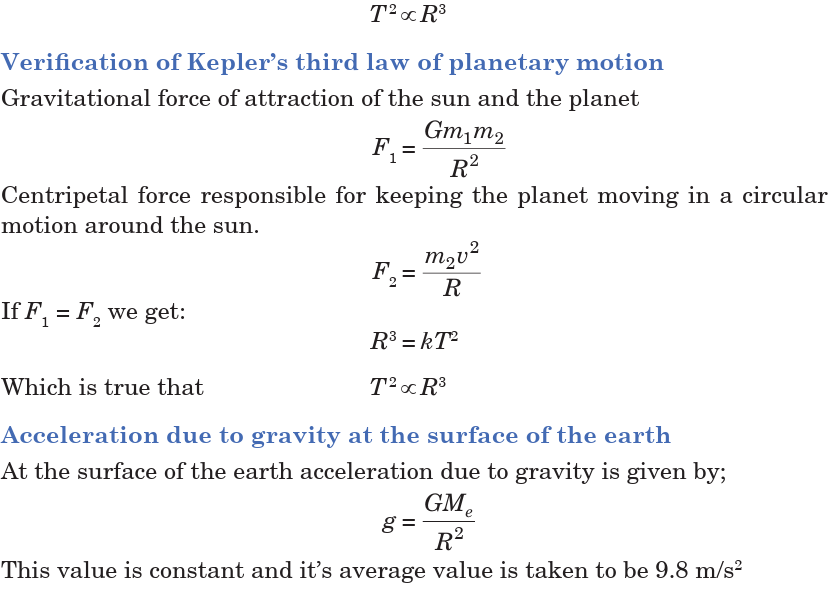
The depth d is measured from the surface of the earth. The value of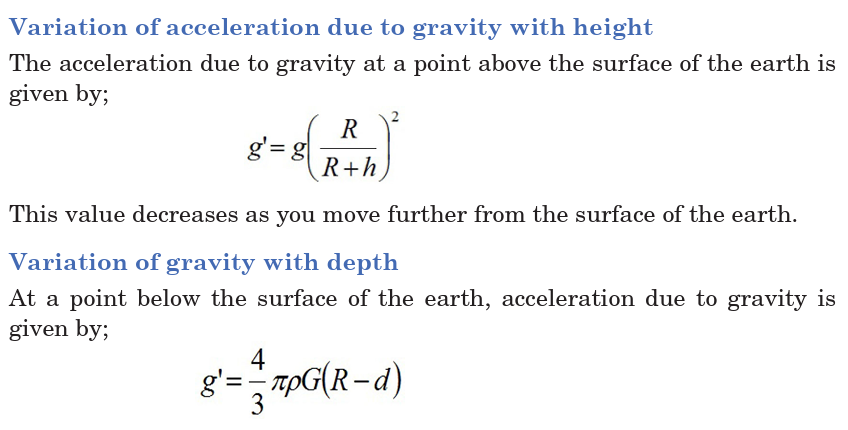
acceleration due to gravity increases as we move towards the surface. At
centre of earth g = 0.
Variation in g Due to Rotation of Earth
As the earth rotates, a body placed on its surface moves along the circular
path and hence experiences centrifugal force, due to which the apparent
weight of the body decreases.By solving, the acceleration due to gravity is given by;

Rockets and spacecraft
A rocket is a device that produces thrust by ejecting stored matter. Spacecraft
Propulsion is characterized in general by its complete integration withinthe spacecraft (e.g. satellites).
Satellites
A satellite is an artificial body placed in orbit round the earth or anotherplanet in order to collect information or for communication.
It is seen that angular momentum of satellite depends on both the mass of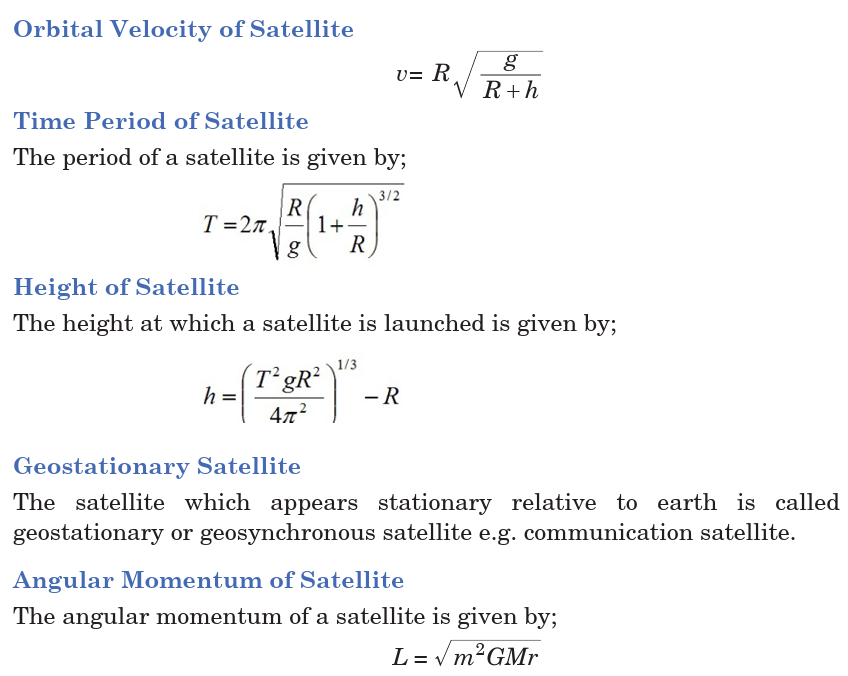
orbiting and central body as well as the radius of orbit.
Energy of Satellite
When a satellite revolves around a planet in its orbit, it possesses both
potential energy (due to its position against gravitational pull of earth) andkinetic energy (due to orbital motion).
Types and applications of Satellite Systems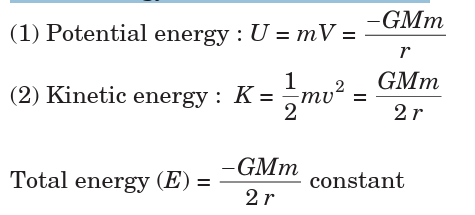
• GEO (Geo-stationary earth orbit)
• MEO (medium earth orbit)
• LEO (Low earth orbit) and
• HEO (Highly elliptical orbit)
Cosmic velocity
The first cosmic velocity
v1= 7900 m/s
Second cosmic velocity
This is also called the escape velocity, v2 = 11200 m/s
Third cosmic velocity
The third cosmic velocity is the initial velocity which a body has to have to
escape the Solar System and its value is given by;
v3 = 16.7 km/s
